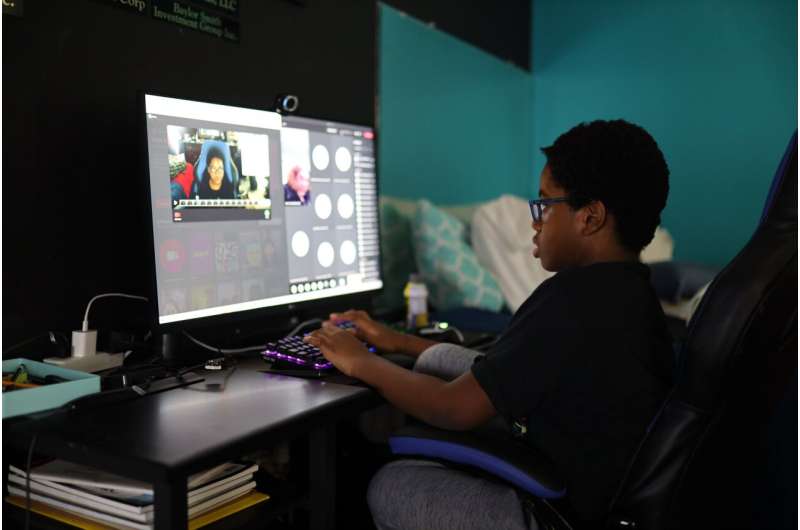This article has been reviewed according to Science X's editorial process and policies. Editors have highlighted the following attributes while ensuring the content's credibility:
fact-checked
peer-reviewed publication
trusted source
proofread
Virtual learning linked to rise in chronic absenteeism, study finds

Since the COVID-19 pandemic, rates of chronic absenteeism have nearly doubled across the nation for students in kindergarten through grade 12.
This increase was tied to the mode of instruction during the early years of the pandemic. In particular, schools that employed virtual learning as the primary teaching mode during the 2020–21 school year experienced a greater increase in chronic absenteeism in the following year.
That increase was significantly greater in school districts with higher levels of poverty, according to new research from the University of Notre Dame.
William Evans, the Keough-Hesburgh Professor of Economics and co-founder of Notre Dame's Wilson Sheehan Lab for Economic Opportunities, co-authored the study with current undergraduate student Kathryn Muchnick and 2024 graduate Olivia Rosenlund. Their work was recently published in JAMA Network Open.
The study analyzed data for two years from more than 11,000 school districts across the United States and found that chronic absenteeism rates increased from 16% in 2018–19 to nearly 30% in the 2021–22 school year.
Students whose schools had full virtual instruction during the pandemic had chronic absenteeism rates that were nearly 7 percentage points higher than those schools that were fully in person, according to the research.
A student is considered chronically absent if he or she misses at least 10% of the instructional days in any given school year. That equates to more than three weeks of absences during a 180-day academic year.
As reported in the study, chronic absenteeism has been shown to lead to lower test scores, reduced social and educational interactions, lower rates of high school graduation and increased substance use. The increase in chronic absenteeism began to occur as public schools in the U.S. were attempting to return to pre-pandemic modes of in-person teaching.
Previous studies have indicated that moving away from in-person instruction during the 2020–21 school year to online teaching methods reduced student achievement and educational development, adversely affected children's mental well-being and decreased school enrollment.
"We've learned a lot from the pandemic," Evans said, "and a lot of work has gone into researching what effects virtual learning has had on students. It's really difficult when you disrupt their educational experience by going remote."
Both of Evans' co-authors were high school students during the pandemic, giving them a uniquely personal perspective on the study's results. Rosenlund said that when she entered the end of her senior year with fully virtual classes, she and her classmates "definitely had lower motivation to learn during that time compared to when class was fully in person."
Muchnick added, "The shift in student motivation after online learning [back to in-person] was palpable."
The research also indicated that chronic absenteeism rates hit at-risk students and school districts with the highest levels of poverty the hardest. Those school districts saw chronic absenteeism soar more than 10 percentage points higher among students who had participated in fully remote instruction, versus in-person learning.
"There is growing evidence that those in the most precarious situations were the ones that were really hurt the most by virtual instruction," Evans said. "The districts with higher levels of poverty had higher rates of chronic absenteeism already, and they were much more aggressive at using virtual learning during COVID.
"So you took a vulnerable population, used this method of delivery for educational instruction, and the outcomes for these children are substantially worse."
Households with lower incomes or fewer resources were less likely to have reliable or high-speed internet service and had far less access to quality computers or technology, making for a less-than-ideal virtual learning environment.
"It was pretty detrimental for those kids who were most at risk in the first place," Evans added, "and now they've been pushed further behind as a result of these policies."
Although the study did not specifically explore the reasons behind the drop in school attendance, it did offer several possible explanations.
First, roughly 10% to 20% of students were experiencing post-COVID-19 symptoms and may have elected not to go to school for medical and health reasons.
Second, there was a corresponding increase in teacher absences and substitute teacher shortages that made students less compelled to go to school.
Third, a greater occurrence of mental health issues, which is often coupled with an increased preoccupation with social media, may have kept students at home.
Finally, following the pandemic, parents appear to be more willing to allow their children to miss school for a variety of reasons.
With the worst of the pandemic behind us, many parents, school teachers and administrators believe that virtual instruction is here to stay and will continue as a major component of K-12 education, potentially being used as a substitute for in-person teaching under certain circumstances, such as snow days.
"It's going to be really difficult to put the genie back in the bottle in this context," Evans said.
Finding a balance of how to use virtual learning in a way that does not negatively impact the students' overall educational experience will be crucial, according to the researchers.
Rosenlund added, "It's disheartening that students are still suffering from the negative effects of online learning. I hope that we can consider its implications more carefully going forward."
The researchers suggest that educators and policymakers examine the evidence when establishing policies and practices related to online learning, particularly for those communities supporting at-risk students, in order to achieve equitable outcomes for all students.
"I think we need to take a more holistic approach in thinking about how to deal with these pandemics in the future," Evans said.
More information: William N. Evans et al, Virtual Learning in Kindergarten Through Grade 12 During the COVID-19 Pandemic and Chronic Absenteeism, JAMA Network Open (2024). DOI: 10.1001/jamanetworkopen.2024.29569
Journal information: JAMA Network Open
Provided by University of Notre Dame





















